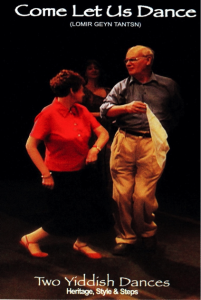Come Let Us Dance (LOMIR GEYN TANTSN)
Two Yiddish Dances
Heritage, Style & Steps
We learn of Mrs. Rochlin’s own history in Germany (also documented by the Shoah Foundation), and her work in Los Angeles with director/choreographer BENJAMIN ZEMACH (1901, Bialystok, — 1997, Israel). Zemach and Vizonsky were both E. European born and from traditional backgrounds. Both trained in modern dance, ballet and theater, and each had created 1930s Jewish dance companies. Later, when both were in L.A., Zemach invited Vizonsky to teach Yiddish style to Zemach’s company.
Come Let Us Dance becomes not only a document of two dances but, a glimpse of how Jewish communities and artists from Europe to America negotiated the task of remembering tradition in ever-changing circumstances, while contributing to the cultural life of the countries in which they lived.
COME LET US DANCE IS A TRUE TREASURE AND A MUST SEE FILM FOR THOSE INTERESTED IN YIDDISH DANCES AND EASTERN EUROPEAN JEWISH CULTURE. PRESENTING A RARE VISUAL WINDOW INTO THE MOVEMENT, STYLE, AND HISTORY OF THIS FORM, THE FILM IS VERSATILE AND CAN BE USED BOTH TO LEARN SEVERAL DANCES DIRECTLY, AS WELL AS TO DEEPEN UNDERSTANDING ABOUT THEIR MEANING. AND THE FOOTAGE OF MIRIAM ROCHLIN, WHO SERVED AS AN ASSISTANT TO BENJAMIN ZEMACH, IS A HISTORICAL FIND! THE FILM IS WELL SUITED FOR USE IN UNIVERSITY COURSES ON TOPICS SUCH AS JEWISH DANCE AND EASTERN EUROPEAN JEWISH CULTURE. I HIGHLY RECOMMEND IT!– Nina Spiegel, Rabbi Joshua Stampfer Associate Professor of Israel Studies, Portland State University. Author of Embodying Hebrew Culture: Aesthetics, Athletics and Dance in the Jewish Community of Mandate Palestine. (Wayne State University Press, 2013). Finalist for a 2013 National Jewish Book Award. 2022
…OFFERS NOT ONLY A STEP-BY-STEP JUMPSTART TO YIDDISH DANCE BUT ALSO A HISTORIC APPRECIATION OF THIS WANING FACET OF JEWISH CULTURAL HERITAGE.”
– The Detroit Jewish News, 2003
CHOREOGRAPHER KAREN GOODMAN LOOKS AT THE TRADITION OF YIDDISH DANCE …TEACHING THE DANCES … IS ACTRESS-DANCER MIRIAM ROCHLIN, A LUMINOUS FIGURE NOW OVER 80 WHO CAME TO LOS ANGELES AFTER EMIGRATING FROM BERLIN.
– Elizabeth Zimmer, The Village Voice, 2003
KAREN GOODMAN DID THE, AHEM, FOOTWORK, AND NOW WE GLEAN THE REWARDS.
– The Jewish Journal, Los Angeles, 2003
…OFFERS NOT ONLY A STEP-BY-STEP JUMPSTART TO YIDDISH DANCE BUT ALSO A HISTORIC APPRECIATION OF THIS WANING FACET OF JEWISH CULTURAL HERITAGE.”
– The Detroit Jewish News, 2003
CHOREOGRAPHER KAREN GOODMAN LOOKS AT THE TRADITION OF YIDDISH DANCE …TEACHING THE DANCES … IS ACTRESS-DANCER MIRIAM ROCHLIN, A LUMINOUS FIGURE NOW OVER 80 WHO CAME TO LOS ANGELES AFTER EMIGRATING FROM BERLIN.
– Elizabeth Zimmer, The Village Voice, 2003
KAREN GOODMAN DID THE, AHEM, FOOTWORK, AND NOW WE GLEAN THE REWARDS.
– The Jewish Journal, Los Angeles, 2003

 Growing up in a Hasidic family, he went from cheder and ballet class in Lodz, to a ballet scholarship and performing in Berlin, to detention there as a WWI “enemy alien,” and an arduous journey to the U.S. in 1921. Living in Chicago, he became one of the earliest people to analyze and write about Yiddish folk dance in 1930, where he choreographed the first major American Jewish pageant, Romance of a People, at Soldier Field for the 1933 Chicago World’s Fair’s Jewish Day.
Growing up in a Hasidic family, he went from cheder and ballet class in Lodz, to a ballet scholarship and performing in Berlin, to detention there as a WWI “enemy alien,” and an arduous journey to the U.S. in 1921. Living in Chicago, he became one of the earliest people to analyze and write about Yiddish folk dance in 1930, where he choreographed the first major American Jewish pageant, Romance of a People, at Soldier Field for the 1933 Chicago World’s Fair’s Jewish Day. When Karen Goodman met Miriam Rochlin in 1999 and learned of her background and of Mr. Vizonsky’s long out-of-print book, the idea for this documentary was born. Mrs. Rochlin’s wealth of knowledge from a life steeped in Jewish religious and cultural traditions inspired Goodman to turn personal research into a documentary. Mrs. Rochlin provides an insightful and witty commentary on the style and feeling of the dances and the lives of the people who danced them.
When Karen Goodman met Miriam Rochlin in 1999 and learned of her background and of Mr. Vizonsky’s long out-of-print book, the idea for this documentary was born. Mrs. Rochlin’s wealth of knowledge from a life steeped in Jewish religious and cultural traditions inspired Goodman to turn personal research into a documentary. Mrs. Rochlin provides an insightful and witty commentary on the style and feeling of the dances and the lives of the people who danced them.